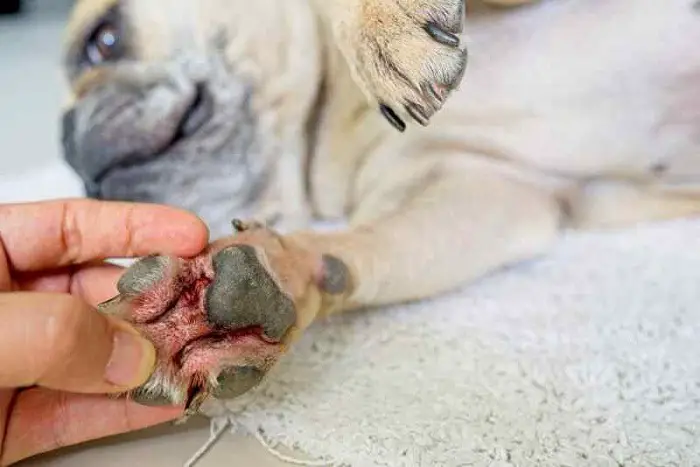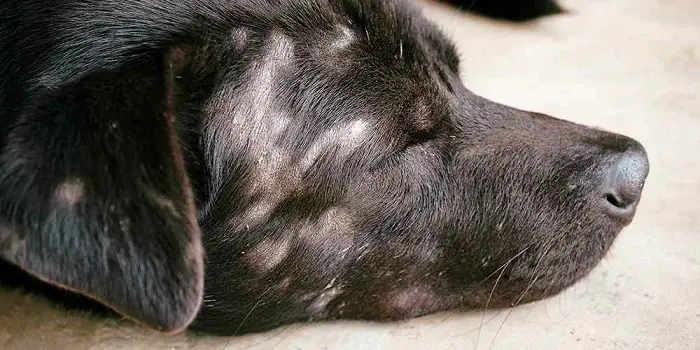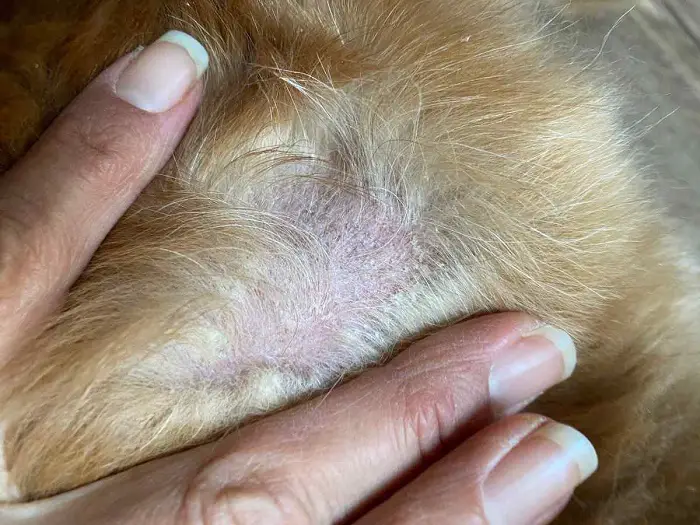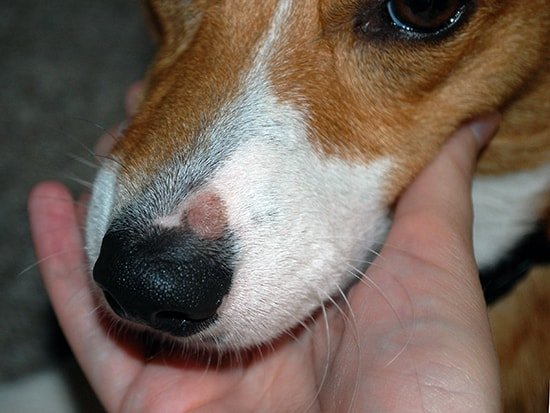A fungal infection in dogs is a medical condition where pathogenic fungi invade a dog’s body. Fungal infections in dogs can affect various body parts, including the skin, respiratory system, ears, or internal organs. Fungal infections in dogs can be challenging to diagnose and treat. Common symptoms may include itching, hair loss, redness, swelling, discharge, coughing, sneezing, and more, depending on the type and location of the infection.
Treatment typically involves antifungal medications, which may be administered orally, topically, or IV, depending on the severity and location of the infection. It’s essential to consult a veterinarian if you suspect your dog has a fungal infection, as early detection and treatment are essential for a successful outcome.
Causes of Fungal Infection in Dogs
A variety of fungi are responsible for fungal infections in dogs. The causes of these infections often relate to how the dog comes into contact with the fungal pathogens. Common causes of fungal infections in dogs include:
- Environmental Exposure: Dogs can contract fungal infections by coming into contact with fungal spores or elements in their environment. This can occur through inhalation, skin contact, or ingestion. Fungal spores may be present in soil, decaying organic matter, and bird droppings. Dogs that dig or explore in outdoor areas may be at greater risk.
- Weakened Immune System: A weakened or compromised immune system can make dogs more susceptible to fungal infections. Conditions such as cancer, diabetes, or long-term steroid use can suppress the immune system’s ability to fight off fungal pathogens.
- Living in Endemic Areas: Some fungal infections are more common in specific geographic regions. For example, Coccidioidomycosis (Valley Fever) is prevalent in arid regions of the United States. Dogs living in or visiting these areas are more likely to contract the infection.
- Contact with Infected Animals: Fungal infections, particularly ringworm, can be transmitted from one animal to another. Dogs that come into contact with infected animals or contaminated bedding, grooming tools, or living spaces can contract the infection.
- Wounds or Skin Abrasions: Fungi can enter a dog’s body through wounds or skin abrasions. Fungal spores in the environment can invade the dog’s skin or underlying tissues, leading to localized or systemic infections.
- Prolonged Moisture: Moisture and humidity can create ideal conditions for fungal growth. Dogs with skin folds or those exposed to constant damp conditions may be more susceptible to yeast infections in these areas.
- Age and Breed: Some breeds may be more prone to specific fungal infections due to genetic predispositions. Additionally, age can be a factor, as puppies and senior dogs may have weaker immune systems and are more susceptible.
Types of Canine Fungal Infections
Several types of fungal infections can affect dogs. These diseases are caused by various fungal pathogens, each with its unique characteristics and symptoms. Some common types of canine fungal infections include:
- Dermatophytosis (Ringworm): Ringworm is one of dogs’ most common fungal infections. It affects the skin and can cause circular, red, and itchy lesions. Despite its name, it is not caused by a worm but by different fungal species known as dermatophytes, including Microsporum and Trichophyton species. Ringworm is highly contagious and spreads to humans as well.
- Malassezia Dermatitis: Malassezia is a yeast that can overgrow on a dog’s skin and in the ears, leading to itching, redness, and a characteristic odor. This condition is known as Malassezia dermatitis or yeast dermatitis.
- Blastomycosis in Dogs: Blastomycosis is a systemic fungal disease caused by the fungus Blastomyces dermatitidis. It can affect the lungs, skin, bones, and other organs. Dogs typically contract Blastomycosis by inhaling spores from the environment.
- Histoplasmosis in Dogs: Histoplasmosis is another systemic fungal infection that affects dogs. Histoplasmosis is caused by Histoplasma capsulatum, which is found in certain soils and bird droppings. Dogs contract this infection by inhaling fungal spores.
- Coccidioidomycosis (Valley Fever): Coccidioidomycosis is a systemic fungal infection caused by Coccidioides species. It primarily affects the respiratory system and is commonly found in arid regions, particularly in the southwestern United States. Dogs become infected by inhaling fungal spores.
- Aspergillosis: Aspergillosis is a fungal infection that often affects the respiratory system, particularly the nasal passages and sinuses. It is caused by the fungus Aspergillus. Dogs can contract this infection by inhaling airborne fungal spores.
- Cryptococcosis: Cryptococcosis is another systemic fungal infection that may affect the respiratory and nervous systems. The yeast Cryptococcus neoformans cause it and is typically contracted through inhalation of fungal spores.
- Sporotrichosis in Dogs: Sporotrichosis is a fungal infection caused by the fungus Sporothrix schenckii. It can result from contact with contaminated soil, plants, or organic matter, leading to skin lesions and, in severe cases, systemic infection.
- Candidiasis: Candidiasis is a yeast infection caused by Candida species. It can affect various body parts, including the skin, ears, and mucous membranes. Dogs with weakened immune systems or those on long-term antibiotics are more susceptible.
Clinical Signs of Fungal Infection in Dogs
Clinical signs of fungal infections in dogs may differ depending on the type of fungus involved, the location of the infection, and the dog’s health. Here are some common clinical signs and symptoms that may indicate a fungal infection in dogs:
- Skin Lesions: Fungal skin infections, such as ringworm (dermatophytosis), can cause circular, red, and itchy lesions on the skin. These lesions may have a raised, scaly edge and can occur in various body areas.
- Hair Loss: Patchy hair loss (alopecia) is often associated with fungal skin infections. Dogs may have areas of baldness or thinning hair in affected areas.
- Itching and Scratching: Dogs with fungal infections may exhibit intense itching, leading to excessive scratching, licking, or chewing at the affected areas.
- Redness and Swelling: Affected skin can become red and inflamed due to fungal irritation. This can be particularly noticeable in the case of yeast infections.
- Odor: Some fungal infections, especially yeast infections like Malassezia dermatitis, can have a characteristic, musty odor on the skin or ears.
- Ear Problems: Fungal ear infections can lead to symptoms such as head shaking, ear scratching, ear discharge, and discomfort. Dogs with ear infections may tilt their heads to one side.
- Respiratory Symptoms: Fungal respiratory infections, like Blastomycosis or Aspergillosis, can cause coughing, sneezing, nasal discharge, and difficulty breathing. Dogs may also exhibit lethargy and a reduced appetite.
- Eye Problems: In some cases, fungal infections can affect the eyes, leading to symptoms like redness, discharge, squinting, and inflammation.
- Lethargy: Dogs with systemic fungal infections may experience general weakness, fatigue, and a decreased desire to be active.
- Fever: Fungal infections can cause a rise in body temperature, leading to fever. This is often seen in systemic fungal infections.
- Weight Loss: Dogs with severe or prolonged fungal infections may experience weight loss due to a decreased appetite and the energy expended to combat the infection.
- Neurological Symptoms: In systemic fungal infections affecting the nervous system, dogs may exhibit neurological signs such as seizures, disorientation, and changes in behavior.
- Swelling and Pain: In some cases, fungal infections can manifest swelling and pain in the affected areas, such as joints or bones, especially in systemic fungal infections like Blastomycosis or Coccidioidomycosis.
Diagnosis of Canin Fungal Infections
The diagnosis of canine fungal infections typically involves a combination of clinical observations, laboratory tests, and sometimes imaging studies. Here are some of the standard methods used by veterinarians to diagnose fungal infections in dogs:
- Clinical Examination: The veterinarian will start with a thorough physical examination of the dog. They will look for characteristic signs and symptoms such as skin lesions, itching, respiratory symptoms, or other clinical indications of a fungal infection.
- Clinical History: A detailed history of the dog’s symptoms, travel history, exposure to specific environments, and any recent changes in behavior or health is crucial for diagnosing fungal infections.
- Fungal Culture: Fungal culture is a definitive diagnostic test for fungal infections. This test collects samples from the affected area, such as skin, hair, or ear discharge, and is placed in a culture medium to grow the fungus. Once the fungus grows, it can be identified. This method helps determine the specific fungus causing the infection.
- Skin Scrapings Examination: For dermatophyte infections like ringworm, skin scrapings may be collected and examined under a microscope to identify fungal elements or to initiate a fungal culture.
- Examination of Blood: Blood tests, such as serology and antibody tests, can help detect antibodies against specific fungal pathogens in the bloodstream. This can be particularly useful in systemic fungal infections like Blastomycosis or Histoplasmosis.
- Imaging Studies: Radiographs (X-rays) or other imaging studies may be performed to evaluate the extent of fungal diseases in the lungs or other organs, especially in cases of respiratory fungal infections.
- Cytology: Cytology involves examining cells from a sample taken from the affected area (such as ear discharge, skin scrapings, or tissue biopsy) under a microscope. This can reveal fungal elements or characteristic changes in cells that may indicate a fungal infection.
- Biopsy: A biopsy of affected tissue may be necessary to confirm the presence of fungal organisms. Biopsy samples are examined microscopically, and cultures may be attempted.
- PCR Testing: Polymerase chain reaction (PCR) testing is a molecular technique that detects specific fungal pathogens’ genetic material (DNA). PCR can be a valuable tool for identifying the causative organism.
Treatment of Fungal Infections in Dogs
The treatment of fungal infections in dogs can be complex and typically involves using antifungal medications, supportive care, and, in some cases, changes in the dog’s environment. The specific treatment line will depend on the type of fungal infection, its severity, and the dog’s overall health. Here are some standard methods and considerations for the treatment of fungal infections in dogs:
- Antifungal Medications: Antifungal drugs are the primary treatment for most canine fungal infections. Depending on the infection’s location and severity, these medications can be administered orally, topically, or intravenously. The choice of antifungal medication will depend on the specific fungus involved. Some commonly used antifungal drugs include:
- Fluconazole
- Ketoconazole
- Itraconazole
- Amphotericin B
- Terbinafine
- Topical Treatments: In cases of fungal skin infections, topical antifungal creams, ointments, or shampoos may be used. These can help treat localized infections and provide relief from itching and discomfort.
- Systemic Treatment: Systemic fungal infections, which affect internal organs or the respiratory system, typically require systemic antifungal medications. These medications circulate throughout the dog’s body to target the infection.
- Supportive Care: Dogs with fungal infections may require supportive care to manage symptoms and support their overall health. This can include medications to control pain, reduce inflammation, and alleviate itching.
- Dietary Changes: In some cases, dietary changes may be recommended to support the dog’s immune system and overall health. Providing a well-balanced diet can help the dog’s body fight off the infection.
- Environmental Management: If the fungal infection is thought to have been acquired from the dog’s environment, measures may be taken to reduce the dog’s exposure to the pathogen. This could include cleaning and disinfecting living areas or preventing the dog from digging in contaminated soil.
Prevention of Canine Funga Infections
Preventing fungal infections in dogs primarily involves minimizing your dog’s exposure to fungal pathogens and maintaining their overall health. While it’s not always possible to prevent fungal infections entirely, the following measures can help reduce the risk of your dog contracting such infections:
- Keep Living Areas Clean and Dry: Regularly clean and disinfect your dog’s living area, including bedding, crates, and toys. Ensure the environment is well-ventilated and not excessively damp, as fungi thrive in moist conditions.
- Limit Exposure to Contaminated Soil: Be cautious when allowing your dog to dig in or consume soil, especially when fungal pathogens are prevalent. Consider using a leash or providing supervised playtime in such environments.
- Avoid High-Risk Areas: If you live in an area known for specific fungal infections (e.g., Valley Fever in the southwestern United States), be aware of the risks and limit your dog’s exposure to contaminated areas.
- Proper Grooming: Regular grooming can help maintain your dog’s skin and coat health. Brushing and bathing can remove debris, dirt, and loose hair that may harbor fungal spores.
- Monitor Ear Health: Keep your dog’s ears clean and dry, especially if they are prone to ear infections. Dogs with floppy ears may benefit from more frequent ear cleaning.
- Regular Vet Check-Ups: Schedule routine veterinary check-ups for your dog to monitor their overall health and detect any underlying conditions that could weaken the immune system, making them more susceptible to fungal infections.
- Vaccinations: Some fungal vaccines are available for dogs in areas where specific infections are common. Please discuss with your veterinarian whether vaccination is appropriate for your dog based on their location and risk factors.
- Prevent Ringworm Spread: If you have multiple pets, isolate any animal with a diagnosed fungal infection like ringworm. Take measures to prevent the spread of the infection to other pets or humans.
- Proper Nutrition: Feed your dog balanced food to ensure they receive the necessary nutrients to maintain a healthy immune system. A sound immune system is biologically equipped to resist fungal infections.
- Prompt Treatment: If you see your dog has a fungal disease, seek veterinary care promptly. Early detection and treatment can prevent the infection from worsening and spreading.
- Training and Supervision: Train your dog to avoid consuming unknown or potentially contaminated substances outdoors, as dogs often explore the environment through their mouths.
- Protective Clothing: If you live in an area with endemic fungal diseases like Valley Fever, consider using protective clothing or keeping your dog indoors during dust storms or in areas with high spore concentrations.
Concluding Remarks on Fungal Infection in Dogs
Fungal infections in dogs can be a challenging and sometimes severe health concern. These infections can affect a dog’s skin, respiratory system, ears, or internal organs, and they often present with a range of symptoms, including skin lesions, itching, coughing, and more. Dog owners must know the risk factors, signs, and prevention measures to protect their pets.
In conclusion, fungal infections in dogs are a health concern that requires careful attention and prompt veterinary care. With early detection, proper treatment, and preventive measures, you can help protect your canine companion from these infections and provide them with a healthy and happy life. Always consult a qualified veterinarian for guidance on your dog’s health and any concerns about fungal infections.



